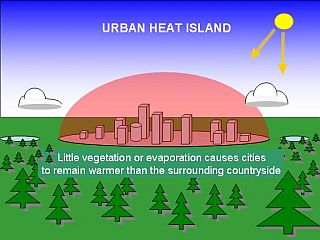It’s true, but not on a global scale . . .
Increases in local temperature averages are due, in large part, to URBANIZATION. For those of us who bother to seek out actual scientific studies, we can clearly see that Urban Heat Islands are the cause of localized increases in temperature. Consider this study from the Center for the Study of Carbon Dioxide and Global Change:
The Urban Heat Island of Mexicali, Mexico
Background
Mexicali City borders the United States at the northern end of Mexico’s Baja California. It is an urban settlement that had its beginnings in the first decade of the 20th century. At that point in time it had an area of approximately 4 km2; but by 1980 it covered an area of a little over 40 km2, and by 2005 it covered something in excess of 140 km2.
What was done
Working with daily records of maximum and minimum temperature from six weather stations “in Mexicali City and its surroundings” covering the period 1950-2000, and with “a climatic network of rural and urban weather stations in Mexicali and its valley and the Imperial Valley, California” over the “contemporary period (2000-2005),” the authors characterized the spatial and temporal development of the city’s urban heat island over the latter half of the 20th century and the first five years of the 21st century.
What was learned
Garcia Cueto et al. state that Mexicali City “changed from being a cold island (1960-1980) to a heat island with a maximum intensity of 2.3°C in the year 2000, when it was compared with rural weather stations of Imperial, California,” noting that “the replacement of irrigated agricultural land by urban landscapes, anthropogenic activity and population growth, appear to be the major factors responsible for the observed changes.” And from the “more updated information (2000-2005),” they found that “the greatest intensity of the urban heat island was in winter with a value of 5.7°C, and the lowest intensity in autumn with 5.0°C.”
What it means
The results of this study clearly demonstrate that population growth and the clustering of people in cities can lead to localized warming (in areas where temperatures are routinely measured) that is both more rapid and much greater (by as much as an order of magnitude, in fact) than what climate alarmists typically attempt to characterize as the “unprecedented” warming of the 20th century. And that population-growth-induced warming — spread across the world — has likely contributed, in large part, to what they wrongly construe to be CO2-induced global warming.
Simply said, CO2 is NOT a dangerous gas.


I’ve known about this effect ever since I was a kid and we would go to visit my grandparents down in San Jose! It was always 15-degrees hotter there, and with less shade!
Damsel, a long time resident of Fremont tells me she observed the same thing those many years ago. Fremont = warm, San Jose = warmer.
Last summer, we were in that area on vacation and, frankly, could have used a little global warming.
Oh, by the way, Mark Twain never made any remarks about coldest winter being a summer in San Francisco regardless of whether it is true: http://www.snopes.com/quotes/twain.asp